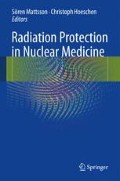Abstract
The lens of the eye is a radiosensitive tissue in the human body. The main detriment following an exposure by ionizing radiation is a cataract of the eye lens but not tumor induction. In 1990, the ICRP has recommended an annual dose limit for the eye lens of 150 mSv for occupational exposed persons and 15 mSv for the public. These limits have again been recommended by ICRP in 2007, but in a recent ICRP statement in 2011, it has been recommended to lower the limit from 150 to 20 mSv per year due to various new epidemiological data dealing with cataracts. The specific structure of the lens, where the stem cells are located in the frontal outer equator region of the lens only, results in a very different radiosensitivity within the eye lens. This becomes important in cases of exposure by low-penetrating radiation, e.g., electrons. The lens of the eye cannot be well modeled by the reference voxel phantoms of ICRP. A detailed geometrical model developed by Behrens et al. is described, and calculations of dose distribution and conversion coefficients for incident electrons and photons are presented. It is discussed which operational dose quantity is appropriate for measurements assessing the equivalent dose to the lens of the eye for incident electrons or photons. Neutrons are of less importance for this discussion.
Access this chapter
Tax calculation will be finalised at checkout
Purchases are for personal use only
References
ICRP (2007) The 2007 recommendations of the international commission on radiological protection. ICRP Publ. 103. Ann ICRP 37(2–4):1–332
Worgul BV, Kundiyev YI, Sergiyenko NM et al (2007) Cataracts among chernobyl cleanup workers: implications regarding permissible eye exposures. Radiat Res 167:233–243
Chodick G, Bekiroglu N, Hauptmann M et al (2008) Risk of cataract after exposure to low doses of ionizing radiation: a 20-year prospective cohort study among US radiologic technologists. Am J Epidemiol 168:620–631
Nakashima E, Neriishi K, Minamoto A (2006) A reanalysis of atomic bomb cataract data, 2000–2002: a threshold analysis. Health Phys 90:154–160
Neriishi K, Nakashima E, Minamoto A, Fujiwara S, Akahoshi M, Mishima HK, Kitaoka T, Shore RE (2007) Postoperative cataract cases among atomic bomb survivors: radiation dose response and threshold. Radiat Res 168:404–408
Cucinotta FA, Manuel FK, Jones J, Iszard G, Murrey J, Djojonegro B, Wear M (2001) Space radiation and cataracts in astronauts. Radiat Res 156:460–466
ICRP (2011) Statement on tissue reactions. ICRP ref 4825-3093-1464 (Approved April 2011)
Charles MW, Brown N (1975) Dimensions of the human eye relevant to radiation protection. Phys Med Biol 20:202–218
ICRP (1955) 1954 Recommendations of the International Commission on Radiological Protection. Brit J Radiol 1955 (Suppl. 6):1–92
ICRP (1996) Conversion coefficients for use in radiological protection against external radiation. ICRP Publ. 74. Ann ICRP 25 (3–4)
Schultz FW, Zoetelief J (1996) Organ and effective doses in the male phantom ADAM exposed in AP direction to broad unidirectional beams of monoenergetic electrons. Health Phys 70:498–504
Kramer R, Zankl M, Williams G, Drexler G (1982) The calculation of dose from external photon exposures using reference human phantoms and Monte-Carlo methods: Part I. The male (ADAM) and female (EVA) adult mathematical phantoms. GSF Bericht S-885 (ISSN 0721-1694)
Behrens R, Dietze G, Zankl M (2009) Dose conversion coefficients for electron exposure of the human eye lens. Phys Med Biol 54:4069–4087 (corrigendum: Phys Med Biol 55: 3937–3945, 2010)
Behrens R, Dietze G (2011) Dose conversion coefficients for photon exposure of the human eye lens. Phys Med Biol 56:415–437
ICRU (1985) Determination of dose equivalents resulting from external radiation sources. ICRU report 39. ICRU Publications, Bethesda, MD
Schlattl H, Zankl M, Petoussi-Henss N (2007) Organ dose conversion coefficients for voxel models of the reference male and female from idealized photon exposures. Phys Med Biol 52:2123–2145
International Organization for Standardization (1999) Calibration of area and personal dosimeters and the measurement of their response as a function of energy and angle of incidence. ISO 4037-3-Part 3, Geneva, Switzerland
Gualdrini G, Mariotti F, Wach S, Bilski P, Denoziere M, Daures J, Bordy J-M, Ferrari P, Monteventi F, Fantuzzi E, Vanhavere F (2011) A new cylindrical phantom for eye lens dosimetry development. Radiat. Meas. 46:1231–1234
International Electrotechnical Commission (2005) Medical diagnostic X-ray equipment – radiation conditions for use in the determination of characteristics IEC 61267. Organization for Standardization, Geneva
Berger MJ et al (1998) Stopping-power and range tables for electrons, protons, and helium ions. NIST standard reference database 124, NISTIR 4999
Behrens R, Dietze G (2010) Monitoring the eye lens: which dose quantity is adequate? Phys Med Biol 55:4047–4062 (corrigendum: Phys. Med. Biol. 56: 511, 2011)
Author information
Authors and Affiliations
Corresponding author
Editor information
Editors and Affiliations
Rights and permissions
Copyright information
© 2013 Springer-Verlag Berlin Heidelberg
About this chapter
Cite this chapter
Dietze, G. (2013). Radiobiology and Radiation Dosimetry for the Lens of the Eye. In: Mattsson, S., Hoeschen, C. (eds) Radiation Protection in Nuclear Medicine. Springer, Berlin, Heidelberg. https://doi.org/10.1007/978-3-642-31167-3_4
Download citation
DOI: https://doi.org/10.1007/978-3-642-31167-3_4
Published:
Publisher Name: Springer, Berlin, Heidelberg
Print ISBN: 978-3-642-31166-6
Online ISBN: 978-3-642-31167-3
eBook Packages: MedicineMedicine (R0)

